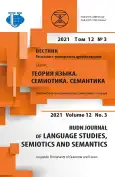Spanish South American and Brazilian Demonyms: Morphosyntactic Structure and Axiological Values
- 作者: Chesnokova O.S.1, Radović M.1, Kotenyatkina I.B.1
-
隶属关系:
- Peoples’ Friendship University of Russia (RUDN university)
- 期: 卷 12, 编号 3 (2021): Linguistic dominants of grammar and lexics
- 页面: 576-596
- 栏目: FUNCTIONAL SEMANTICS AND LINGUISTIC SEMIOTICS
- URL: https://journal-vniispk.ru/2313-2299/article/view/323353
- DOI: https://doi.org/10.22363/2313-2299-2021-12-3-576-596
- ID: 323353
如何引用文章
全文:
详细
This article contributes to the study of the grammar, semantics, expressive values of a very special onymic category, inhabitants’ names, or demonyms. The authors examine and compare demonyms in two varieties of Romanic languages - South American Spanish and Brazilian Portuguese from both a multi-modal point of view and empirical evidence (synchronic and diachronic data) and systemize them by concentrating on their morphosyntactic distinctive features and semiotic content. The perspective revealed in this paper aims to study, define and analyze the main tendencies in the creation of denominative adjectives functioning as demonyms, to establish the parameters of discrepancies and convergences regarding demonyms of the region in question. The authors based on analyzing the motivation sources, grammar formulae, suffix combinations, socio-cultural varieties and the occurrence of homonymy, as well as their significance, axiological values in forming a group identity and the stereotypes they might lead to. The methodology has included semiotic, cognitive, historic and comparative analysis - a synchronic conceptual transdisciplinary analysis. The results of the study confirm the premise that the demonym suffixes randomly alternate in derivation processes, but also demonstrate the existence of other morphological and pragmatic trends while outlining the role of demonyms in migration processes, formation of a linguistic landscape and axiological values.
作者简介
Olga Chesnokova
Peoples’ Friendship University of Russia (RUDN university)
编辑信件的主要联系方式.
Email: tchesnokova-os@rudn.ru
Dr, Professor of Foreign Languages Department
6, Miklukho-Maklaya str., Moscow, Russian Federation, 117198Marija Radović
Peoples’ Friendship University of Russia (RUDN university)
Email: radovich-m@rudn.ru
Ph.D., Assistant Lecturer at the Department of Foreign Languages of the Faculty of Philology
6, Miklukho-Maklaya str., Moscow, Russian Federation, 117198Irina Kotenyatkina
Peoples’ Friendship University of Russia (RUDN university)
Email: kotenyatkina-ib@rudn.ru
PhD, Associate Professor of the Department of Foreign Languages
6, Miklukho-Maklaya str., Moscow, Russian Federation, 117198参考
- Moreno de Alba, J.G. (2001). El español en América. México: Fondo de Cultura Económica. (In Spanish).
- Lipski, J.M. (1996). El español de América. Madrid: Catedra. (In Spanish).
- Stepanov, G.V. (1979). Linguistic Variability: Case Study of European and Latin American Spanish. Moscow: Nauka. (In Russ.).
- Reis Melo, C. & Gomes, J. (2000). Adjetivos pátrios brasileiros. Ao pé da letra, 2, 35—40. (In Portuguese).
- Morera, M. & García Padrón, D. (2013). Los sentidos secundarios de las palabras gentilicias. In: Estudios de lingüística: investigaciones, propuestas y aplicaciones. València: Universitat de València. pp. 461—467. (In Spanish).
- Almela Pérez, R. (2013). Categoría, función y sentido de los gentilicios. Anuario de estudios filológicos, 36, 5—18. (In Spanish).
- Lang, M.F. (2013). Spanish Word Formation. London-New York: Routledge.
- Fajardo Chávez, S. & Kordić Riquelme, R. (2019). Consideraciones morfológicas sobre sobre el gentilicio. Un caso: Chile. RILCE: Revista de Filología Hispánica, 35(2), 416—440. (In Spanish).
- Li, W. (2018). Translanguaging as a Practical Theory of Language. Applied Linguistics, 39(1), 9—30.
- Chesnokova, O.S., Naydenova, N.S. & Radović, M. (2020). The Concept of Glory through the Prism of the Illustrious Personalities of the Pacific Alliance and the Perception of Virtual Linguistic Personality. Philological Sciences. Scientific Essays of Higher Education, 3, 67—77. doi: 10.20339/PhS.3-20.067 (In Russ.).
- Bakhtin, M. (1986). Aesthetics of Verbal Creation. Moscow: Iskusstvo. (In Russ.).
- García Mouton, P. (1992). Sobre geografía lingüística del español de América. Revista de Filología Española, 72(3/4), 699—713. (In Spanish).
- Latorre, G. (1997). Tendencias generales en la toponimia del Norte Grande de Chile. Onomazein, 2, 181—196. (In Spanish).
- Lehnert Santander, R. (1993). La toponimia quechua de la II Región, Hombre y desierto, 6—7, 89—101. (In Spanish).
- Lotman,Yu. (1996) Inside Intellectual Realms. Moscow: Yazyki russkoi kulturi, (In Russ.).
- Chesnokova, O.S. (2011). Toponimia latinoamericana: un enfoque semiótico, Forma y Función, 24(2), 11—24. (In Spanish).
- Chesnokova, O.S. (2014). Colombia in the Spanish-Speaking World. Moscow: RUDN. (In Russ.).
- Talavera-Ibarra, P.L. (2016). History of the Term ‘Latin America’ on the American Continent. Language in a global context Latin America today as a cultural and linguistic phenomenon. In: Collection of reviews and abstracts of Linguistics Department, E.A. Kazak (Ed.) Series. Theory and history of linguistics. Moscow: INION. pp. 11—21.
- Kordić Riquelme, R. & Ferreccio Podestá, M. (2014). Topónimos y gentilicios de Chile. Santiago de Chile: RiL. (In Spanish).
- Radović, M. (2014). Linguistic Analysis of Demonyms in Argentinian and Chilean Spanish. Sovremennye issledovaniya sotsial’nykh problem, 1(17), 12—29. (In Russ.).
- Rádovich, M. (2016). Los gentilicios en las variantes nacionales sudamericanas de la lengua española. In: El mundo iberoamericano, las tradiciones y las tendencias contemporáneas. Moscow: IMI MGIMO MID Rossii. pp. 353—359. (In Russ.).
- Chesnokova, O.S. (2016). Ethnolinguistic Realia of Colombia. In: Yazyk v global’nom kontekste, Latinskaya Amerika segodnya kak kul’turno-yazykovoy fenomen. Moscow: INION. pp. 22—33. (In Russ.).
- Sudar, G.S. (2010). Toponymic Nickname. In: The Issues of Ibero-Romance Linguistics. Moscow: MGU. pp. 229—235. (In Russ.).
- Firsova, N.M. (2008). Spanish and the Culture of Bolivia. Moscow: RUDN. (In Russ.).
- Luna Cabrera, J.E. (2005). Su Majestad el Refrán. Manizales: Editorial Zapata. (In Spanish).
补充文件









